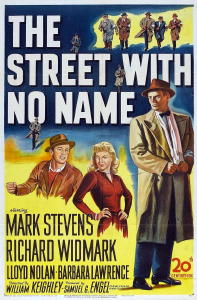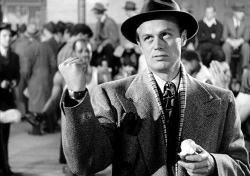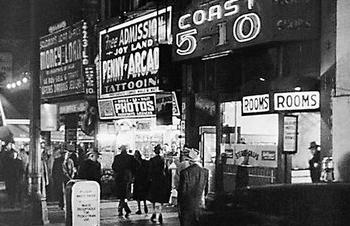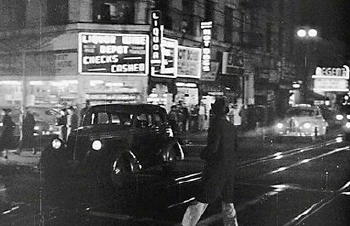Wed 20 Feb 2008
Movie Review – THE STREET WITH NO NAME (1948).
Posted by Steve under Crime Films , Reviews[4] Comments
THE STREET WITH NO NAME. 1948, 20th Century Fox. Mark Stevens, Richard Widmark, Lloyd Nolan, Barbara Lawrence, John McIntire, Donald Buka, Joseph Pevney. Directed by William Keighley.

As a sequel to The House on 92nd Street (Fox, 1945), this film repeats both the semi-documentary style and Lloyd Nolan as FBI agent George Briggs. Immediately after the film’s credit, the following notice appears on the screen:
To obtain Mr. Hoover’s approval for the film, one supposes, the first fifteen minutes are dreadfully and drearily slow. With loud, stentorian music in the background, the audience is dramatically shown the technical advances and training background that agents of the FBI had at their disposal in their new post-war battle against crime.
Mark Stevens, perhaps too good-looking for the role, plays undercover agent Gene Cordell as he tries to gain acceptance into the Alec Stiles gang. It is not until Alec Stiles makes an appearance that the movie begins to gain some footing – and you know who plays Stiles don’t you? You’ve seen the credits, if not the movie. Straight from his major debut in his star-making role as Tommy Udo in Kiss of Death, Richard Widmark.

As the woman-hating, narcissistic and germophobic gang leader Alec Stiles, Widmark tones his portrayal down so that he is only a mere two hairs from lunacy, but they are thick hairs. Lloyd Nolan, whom we think from the beginning is going to be the star, has next to no part at all.
It is on the streets of “Central City” where the action is, with John McIntire as Cordell’s mentor and backup agent Cy Gordon in the rooming house across the street, getting scruffier and shabbier by the minute, but providing Cordell his only protection.
Playing nearly as important a role as Widmark is the aforementioned “street,” actually downtown Los Angeles at the time the movie was filmed, crammed with flop houses, pool halls, penny arcades, cheap restaurants, boxing emporiums, and dives of all sorts and kinds. Filmed largely at night, beginning as the bus rolls in with Cordell on it and getting off, it triggers a sense of 1940s big city sleaze as overpowering and as authentic as you can imagine. Deep down inside, you know that this is (was) as real as it gets.

Noir? Yes, definitely, once the movie’s rid of its documentary trappings. Filmed with a superb sense of black and white, inventive camera angles and taking superb advantage of on-location shooting, this is one of the best views of how the inhabitants of Skid Row managed to exist, if not live, immediately after World War II.
Surprisingly enough, the members of Styles’s gang still wear coats, ties and hats to most of their functions, including poker games, boxing matches, stick-ups, robberies and murders. There is also only one woman in the movie, Barbara Lawrence as Styles’s wife Judy, a cheap, sarcastic moll (even to Styles) if there ever was one and convincingly so, even if, as an actress, she was only 18 or 19 at the time.

I think that there was a little too much violence in the ending, in the manufacturing warehouse filled with all sorts of strange-looking machinery, making for all sorts of terrific shots from a cinemaphotographer’s point of view. I don’t have the technical expertise to describe the latter. Take a look at Mike Grost’s website for that. If you’re interested in reading an in-depth analysis of the movie-making (and movie-watching) aspects of The Street with No Name, there is definitely the place to go.
But, as I began to say, my opinion is that the police were a little too trigger-happy than they should have been. A little? A lot! There is more gunfire in this nifty low budget film noir than I can remember in any of the others I’ve ever seen, but of course there are many I haven’t. Nonetheless, if only the first fifteen minutes could be skipped: you’d have one of the best of them all.
February 20th, 2008 at 5:04 am
An excellent film indeed, later remade by Samuel Fuller into another excellent film (“House of Bamboo”).
February 20th, 2008 at 4:01 pm
Right you are, Xavier. I’m not sure, but I think I have a copy of the remake. If I do, I’ll do my best to watch it and report back soon.
— Steve
February 21st, 2008 at 4:48 pm
You have caught “The Street with No Name” to a T. I especially like your comments about LA’s skid row. This film is indeed the most amazing social portrait, of a whole vanished way of life. Also good was the comment about dressed up the gang members are. Years ago, everyone wanted to be dressed up. You see old photos of people at ball parks or amusement parks, and all the men are in shirts and ties.
Till this post, I never knew that this was a sequel to “The House on 92nd Street”. Just thought that “movie producers sure liked to cast Lloyd Nolan as an FBI agent”! But his character has the same name in both movies… Sequels were quite rare in the 1940’s, aside from whodunit series like The Falcon or The Crime Doctor.
August 17th, 2011 at 9:55 pm
Little trivia; this may have been an intentional inside joke, but near the beginning, when Mark Stevens is first walking down the sleazy streets, there is a movie poster on a building for “Charter Pilot” starring – Lloyd Nolan!